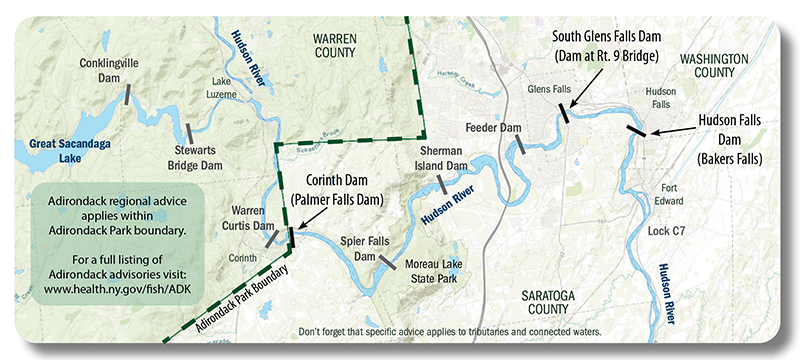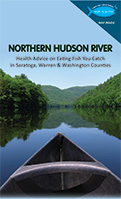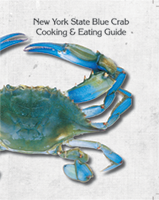Fish Advisories for the Hudson River & Tributaries
The Hudson River offers excellent freshwater and saltwater fishing opportunities between the Adirondack headwaters and New York City's saltwater Upper Bay. The Hudson River is also known for it's world class striped bass fishery. Unfortunately, the river has been impacted by PCB contamination. The advice on the Hudson depends on who you are, where you're fishing, and what you're catching. The Sensitive Population should avoid eating all fish from the Hudson from the South Glens Falls Dam all the way to The Battery. No one should eat striped bass between the Federal Dam in Troy to the Rip Van Winkle Bridge in Catskill. The General Population can eat several species (see tables), but should follow our tips to reduce exposure to PCBs.
Maps of the river sections are available at the bottom of the page.
Advisory Tables
Hudson River Advice
Waterbody 1 (County) |
Fish |
 General Population |
Sensitive Population |
Chemicals of Concern |
|---|---|---|---|---|
| Hudson River, upstream from Corinth Dam (Palmer Falls Dam) (Warren, Essex, Saratoga, Hamilton) |
All fish | See Adirondack Regional Advisory | Mercury | |
| Hudson River, Corinth Dam (Palmer Falls Dam) to South Glens Falls Dam at Route 9 Bridge (Warren, Saratoga) |
Channel catfish | DON'T EAT | DON'T EAT | PCBs |
| Carp | DON'T EAT | DON'T EAT | PCBs | |
| All other fish | See Adirondack Regional Advisory | Mercury | ||
| Hudson River, South Glens Falls Dam at Route 9 Bridge to Hudson Falls Dam at Bakers Falls (Warren, Washington, Saratoga) |
All fish | DON'T EAT | DON'T EAT | PCBs |
| Hudson River, Hudson Falls Dam at Bakers Falls to Federal Dam at Troy (Rensselaer, Albany, Washington, Saratoga) |
All fish | Catch and Release fishing ONLY per NYS DEC regulations. Take No Fish. Eat No Fish. | Catch and Release fishing ONLY per NYS DEC regulations. Take No Fish. Eat No Fish. | PCBs |
| Hudson River, Federal Dam at Troy to Rip Van Winkle Bridge at Catskill 3 (Rensselaer, Albany, Columbia, Greene) |
Yellow perch | Up to 1 meal/month | DON'T EAT | PCBs |
| Rock bass | Up to 1 meal/month | DON'T EAT | PCBs | |
| Blueback herring | Up to 1 meal/month | DON'T EAT | PCBs | |
| Alewife | Up to 1 meal/month | DON'T EAT | PCBs | |
| All other fish (including Striped bass and Walleye) |
DON'T EAT | DON'T EAT | PCBs | |
| Hudson River, Rip Van Winkle Bridge at Catskill to NYC Battery2, 3, 4 (Bronx, Columbia, Dutchess, Greene, New York, Orange, Putnam, Rockland, Ulster, Westchester) |
White perch | Up to 1 meal/month | DON'T EAT | PCBs |
| White catfish | DON'T EAT | DON'T EAT | PCBs | |
| Walleye | DON'T EAT | DON'T EAT | PCBs | |
| Striped bass | Up to 1 meal/month | DON'T EAT | PCBs | |
| Smallmouth bass | Up to 1 meal/month | DON'T EAT | PCBs | |
| Rainbow smelt | Up to 1 meal/month | DON'T EAT | PCBs | |
| Largemouth bass | Up to 1 meal/month | DON'T EAT | PCBs | |
| Freshwater drum | Up to 1 meal/month | DON'T EAT | PCBs | |
| Goldfish | Up to 1 meal/month | DON'T EAT | PCBs | |
| Gizzard shad | DON'T EAT | DON'T EAT | PCBs | |
| Channel catfish | DON'T EAT | DON'T EAT | PCBs | |
| Carp | Up to 1 meal/month | DON'T EAT | PCBs | |
| Crab or lobster tomalley and cooking liquid 2 | DON'T EAT | DON'T EAT | PCBs, Dioxin, Cadmium | |
| Blue crab meat | Up to 4 meals/month (six crabs per meal) | DON'T EAT | PCBs, Cadmium | |
| Brown bullhead | Up to 1 meal/month | DON'T EAT | PCBs | |
| Bluefish | Up to 1 meal/month | DON'T EAT | PCBs | |
| Atlantic needlefish | Up to 1 meal/month | DON'T EAT | PCBs | |
| All other fish | See Statewide Advice (Only for General Population) |
DON'T EAT | PCBs | |
The Sensitive Population refers to people who may become pregnant (under age 50) and children under 15. The General Population refers to everyone else.
1 The specific health advisories for the waters listed above also apply to tributaries and connected waters if there are no dams, falls, or barriers to stop the fish from moving upstream.
2 Don't eat the soft "green stuff' (mustard, tomalley, liver, or hepatopancreas) found in the body section of crabs and lobsters from any waters because cadmium, PCBs, and other contaminants concentrate there. As contaminants are transferred to cooking liquid, you should also discard crab or lobster cooking liquid.
3 Check the NYS DEC website for updated regulations and special restrictions for certain species.
4 Some fish listed may or may not be found in the more brackish or freshwater portions of this river section.
Additional Resources
Click image to view brochure. To view other publication or order free brochures, visit our publications page.
Maps
Northern Hudson River Map

Hudson River Map




